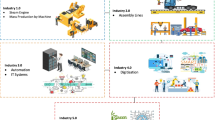Abstract
One shortcoming of manufacturing information systems is their inability to integrate and to enhance different information and related functionalities, such as those found in workflow management. Software agents, once added as a new software layer to an existing system, can overcome this problem. Of the fields applying software agent technology, manufacturing, and especially workflow management, is perhaps the most promising for the development of distributed systems. This potential is reflected in the several ongoing research projects that focus on workflow management and share the final aim of integrating and coordinating plant and business activities.
The approach presented in this paper can be regarded as an agent-based architecture applied to an existing workflow management system in order to manage new functionalities, e.g., customer relationship management in electronic commerce. This approach is particularly suitable for small medium enterprises with simple manufacturing information requirements and simple or nonexistent computer based workflow management.
The model and some important features of system implementation, such as the knowledge modeling graphical user interface, the communication model, and a simple practical example of the architecture's use, are described.
Similar content being viewed by others
References
Aparicio M. IV. Internet-scale network intelligence. IEEE Internet Computing 1999;3(5):38-40.
BizTalk. BizTalk Framework Overview, 2000. Available at http://www.BizTalk.org.
Durrett JR, Burnell LJ, Priest JW. Contingency theoretic methodology for agent-based web-oriented manufacturing systems. In: Berry, Nina M, ed. Proceedings of Network Intelligence: Internet-Based Manufacturing, Boston, Nov. 2000.
Fong E, Ivezic N, Rhodes T, Peng Y. Agent-Based services for B2B electronic commerce. In: Berry, Nina M, ed. Proceedings of Network Intelligence: Internet-based Manufacturing, Boston, Nov. 2000.
Groenvelt H. The just-in-time system. Handbooks in OR & MS, Vol. 14, Elsevier Science Publisher, 1993.
Jennings N. Applying agent technology. Plenary Presentation at PAAM'96, 1996.
Jennings NR, Faratin P, Norman TJ, O'Brien P, Wiegand ME, Voudouris C, Alty JL, Miah T, Mamdani EH. ADEPT: Managing business processes using intelligent agents. BCS Expert Systems 96 Conference (ISIP Track), Cambridge, UK, 1996:5-23.
Kádár B, Monostori L. Agent-Based control of novel and traditional production systems. In: Proceedings of ICME98, CIRP International Seminar on Intelligent Computation in Manufacturing Engineering, Capri, Italy, 1998:31-38.
Kouiss K, Pierreval H, Mebarki N. Using multi-agent architecture in FMS for dynamic scheduling. Journal of Intelligent Manufacturing 1997;8(1):41-47.
Kwok AD, Norrie DH. A development system for intelligent agent manufacturing software. Integrated Manufacturing Systems 1994;5(4/5):64-76.
Lin GYJ, Solberg JJ. Integrated shop floor control using autonomous agents. IIE Transactions: Design and Manufacturing 1992;24(3):57-71.
Maes P. General tutorial on software agents, 1997. Available at http://pattie.www.media.mit.edu.
Mehra A, Nissen M. Intelligent supply chain agents using ADE. In: Proceedings of AI & Manufacturing Research PlanningWorkshop, Albuquerque, NM, The AAAI Press, 1998:112-119.
Microsoft Technet. MS message queue server overview, 1998.Available at http://www.microsoft.com/technet/default.asp.
Odgers BR, Thompson SG, Shepherdson JW, Cui Z, Judge DW, O'Brien PD. Technologies for intelligent workflows: Experiences and lessons. In: Proceedings of Agent-Based Systems in the Business Context, AAAI 1999 Workshop.
Onosato M, Iwata K. Development of a virtual manufacturing system by integrating product models and factory models. CIRP Annals 1993;42(1):475-478.
Parunak HVD. Industrial and practical applications ofDAI. In:Weiss G, ed. Multiagent Systems: A Modern Approach to Distributed Artificial Intelligence, Cambridge, MA: MIT Press, 1999:377-421.
Parunak HVD. A practitioners' review of industrial agent applications.Autonomous Agents and Multi-Agent Systems 2000;3:389-407.
Peng Y, Finin T, Labrou Y, Chu B, Long J, Tolone WJ, Boughannam A.Amulti-agent system for enterprise integration. In: Proceedings of PAAM'98, London, 1998.
Riley G. Clips: A tool for building expert systems, August 28, 1999.Available at http://www.ghg.net/clips/CLIPS.html.
Sacile R, Paolucci M, Boccalatte A. The MAKE-IT project: Manufacturing agents in a knowledge-based environment driven by internet technologies. In: Proc. IEEE-AIWORK-2000: An International Working Conference and Industrial Expo on New Advances and Emerging Trends in Virtual Enterprises and Mobile Computing, Buffalo (NY), April 27-29, 2000a:191-196.
Sacile R, Paolucci M, Boccalatte A. Cop-like: A knowledge based system for the co-ordination and planning of manufacturing shop-floor information. Ifac/Ifip/IeeeMCPL2000, Conference On Management & Control Of Production&Logistics, Grenoble, July 5-8, 2000b:103-108.
Satapathy G, Kumara RTS, Moore LM. Distributed intelligent architecture for logistics (DIAL). Expert Systems with Applications 1998:409-424.
Schäl T. Workflow management systems for process organization.Lecture Notes in Computer Science, Vol. 1096. Berlin: Springer-Verlag, 1996.
Shen W, Norrie DH. Agent based system for intelligent manufacturing: A state of the art survey. Knowledge and Information Systems 1999:129-156.
Shepherdson JW, Thompson SG, Odgers BR. Decentralised workflows and software agents. BT Technical Journal 1999; 17(4).
Shoham Y. Agent-oriented programming. Artificial Intelligence 1993;60(1):51-92.
Teti R, Kumara SRT. Intelligent computing methods for manufacturing systems. CIRP Annals 1997;46(2):629-652.
Wooldridge M. Intelligent agents. In: Weiss G, ed. Multiagent Systems: A Modern Approach to Distributed Artificial Intelligence, Cambridge, MA: MIT Press, 1999:27-77.
Wooldridge M, Jennings NR. Agent theories, architectures, and languages: A survey. In: Proc. ECAI-Workshop on Agent Theories, Architectures and Languages, Amsterdam, The Netherlands, 1994:1-32.
Workflow Management Coalition. The workflow reference model, 1995. Available at http://www.aiim.org/wfmc/mainframe.htm.
W3 Consortium. Extensible markup language (XML). February 10, 1998. Available at http://www.w3.org.
Author information
Authors and Affiliations
Rights and permissions
About this article
Cite this article
Montaldo, E., Sacile, R. & Boccalatte, A. Enhancing Workflow Management in the Manufacturing Information System of a Small-Medium Enterprise: An Agent-Based Approach. Information Systems Frontiers 5, 195–205 (2003). https://doi.org/10.1023/A:1022605708127
Issue Date:
DOI: https://doi.org/10.1023/A:1022605708127




